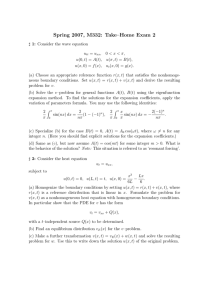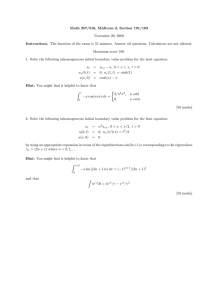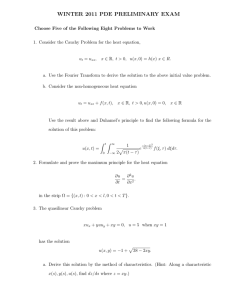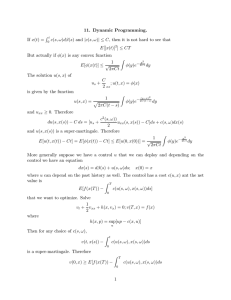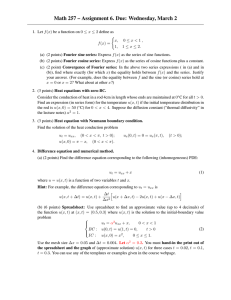PDE 4500 Schwendeman Problem Set 1
advertisement
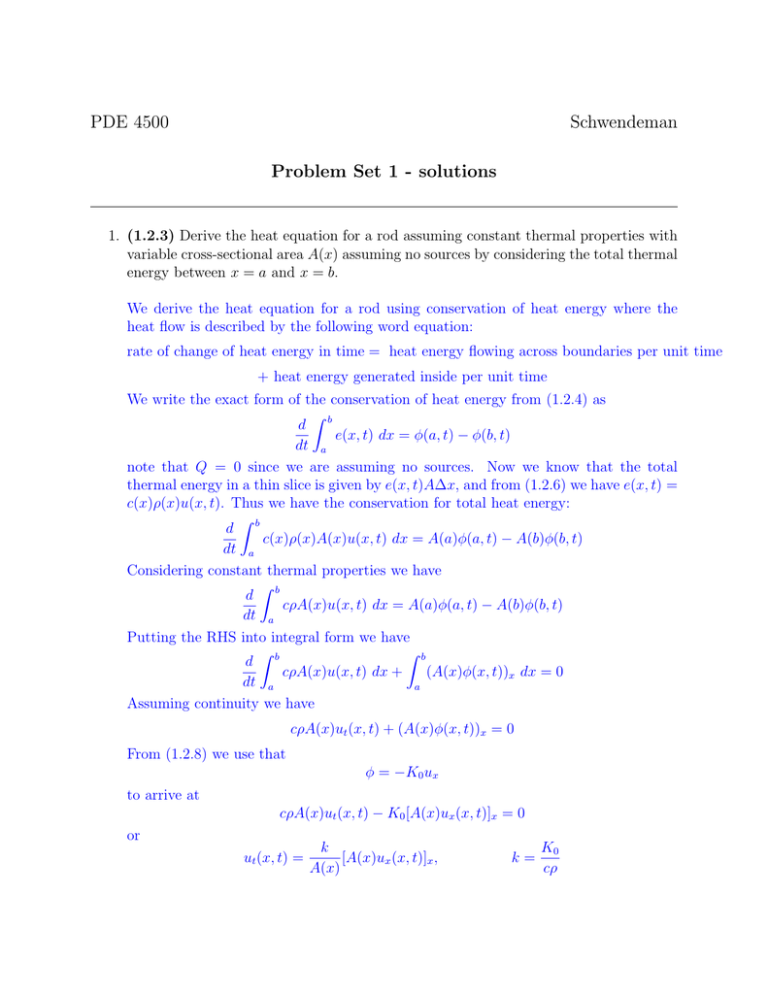
PDE 4500 Schwendeman Problem Set 1 - solutions 1. (1.2.3) Derive the heat equation for a rod assuming constant thermal properties with variable cross-sectional area A(x) assuming no sources by considering the total thermal energy between x = a and x = b. We derive the heat equation for a rod using conservation of heat energy where the heat flow is described by the following word equation: rate of change of heat energy in time = heat energy flowing across boundaries per unit time + heat energy generated inside per unit time We write the exact form of the conservation of heat energy from (1.2.4) as Z d b e(x, t) dx = φ(a, t) − φ(b, t) dt a note that Q = 0 since we are assuming no sources. Now we know that the total thermal energy in a thin slice is given by e(x, t)A∆x, and from (1.2.6) we have e(x, t) = c(x)ρ(x)u(x, t). Thus we have the conservation for total heat energy: Z d b c(x)ρ(x)A(x)u(x, t) dx = A(a)φ(a, t) − A(b)φ(b, t) dt a Considering constant thermal properties we have Z d b cρA(x)u(x, t) dx = A(a)φ(a, t) − A(b)φ(b, t) dt a Putting the RHS into integral form we have Z Z b d b (A(x)φ(x, t))x dx = 0 cρA(x)u(x, t) dx + dt a a Assuming continuity we have cρA(x)ut (x, t) + (A(x)φ(x, t))x = 0 From (1.2.8) we use that φ = −K0 ux to arrive at cρA(x)ut (x, t) − K0 [A(x)ux (x, t)]x = 0 or ut (x, t) = k [A(x)ux (x, t)]x , A(x) k= K0 cρ 2. (1.2.9) Consider a thin one-dimensional rod without sources of thermal energy contained in a rod (0 < x < L) (a) Assume that the heat energy flowing out of the lateral sides per unit surface area per unit time is w(x, t). Derive the partial differential equation for the temperature u(x, t). We incorporate the loss of heat energy from the lateral sides with the following term Z b Z d b cρAu dx = A(φ(a, t) − φ(b, t))− P w(x, t) dx dt a a where P is the lateral perimeter. We again use φ = −K0 ux and divide by A to get cρut (x, t) = (K0 ux (x, t))x − P w(x, t) A (b) Assume that w(x, t) is proportional to the temperature difference between the rod u(x, t) and a known outside temperature γ(x, t). Derive that ∂u ∂ ∂u P cρ = K0 − [u(x, t) − γ(x, t)]h(x) (1) ∂t ∂x ∂x A where h(x) is a positive x−dependent proportionality, P is the lateral perimeter, and A is the cross-sectional area. Let w(x, t) = h(x)(u(x, t) − γ(x, t)) and plug into (1) to get cρut = (K0 ux )x − P h(u − γ) A (c) Compare (1) to the equation for a one-dimensional rod whose lateral surfaces are insulated, but with heat sources. The term − PA h(u − γ) plays the role of a heat source. Page 2 (d) Specialize (1) to a rod of circular cross section with constant thermal properties and 0◦ outside temperature. For a circular cross section, we have the P = 2πr, and A = πr2 where r is the radius. Plugging this into (1) we have 2 cρut = K0 uxx − hu r Or, ut = kuxx − αu, k= 2h K0 , α= cρ cρr (e) Consider the assumptions in part(d). Suppose that the temperature in the rod is uniform [i.e. u(x, t) = u(t)]. Determine u(t) if initially u(0) = u0 . We have uniform temperature distribution and thus our equation from (d) becomes ut + αu = 0, where α = 2h cρr This has the general solution u(t) = Ae−αt . We solve for A using the condition u(0) = u0 and get A = u0 . Thus u(t) = u0 e−αt , where α = 2h cρr 3. (1.4.1) Determine the equilibrium temperature distribution for a one-dimensional rod with constant thermal properties with the following sources and boundary conditions: This gives the PDE Q = 0, K0 which has the following general solution uxx + u=− (c) Q = 0, ∂u (0) ∂x 0<x<L Q 2 x + Ax + B 2K0 = 0, u(L) = T . Plugging Q = 0 into the general solution we have u = Ax + B. Applying the boundary conditions we have that A = 0 and B = T . Thus the solution is u=T Page 3 (e) Q K0 = 1, u(0) = T1 , u(L) = T2 We have the general solution u = − 12 x2 +Ax+B. Applying the first boundary condition 2 we have the B = T1 . Applying the second boundary condition gives − L2 +AL+B = T2 and so A = TL2 + L2 − TL1 . Then T2 L T1 1 2 + − x + T1 u=− x + 2 L 2 L Rearranging gives x x x u = − (x − L) + T1 1 − + T2 2 L L ∂u (g) Q = 0, u(0) = T , ∂x (L) + u(L) = 0 We have the general solution u = Ax + B. Applying the first boundary condition gives −T . Plugging this in we have B = T , and the second gives A + AL + B = 0, or A = 1+L u= −T x+T L+1 4. (1.4.3) Determine the equilibrium temperature distribution for a one-dimensional rod composed of two different materials in perfect thermal contact at x = 1. For 0 < x < 1, there is one material (cρ = 1, K0 = 1) with a constant source (Q = 1), whereas for the other 1 < x < 2 there are no sources (Q = 0, cρ = 2, K0 = 2) with u(0) = 0 and u(2) = 0. For the first material, 0 < x < 1 we have cρ = 1, K0 = 1 which gives the following pde: 0 = uxx + 1 and for the second material, 1 < x < 2, we have Q = 0, cρ = 2, K0 = 2 which gives the following 0 = uxx These two equations have the following general solutions x2 + A1 x + B1 , 2 u(x) = A2 x + B2 , u(x) = − 0<x<1 1<x<2 Applying the boundary condition u(0) = 0 gives B1 = 0 in the first material, and applying the condition u(2) = 0 gives B2 = −2A2 . Then we can write the solution as x2 + A1 x 2 u(x) = A2 (x − 2) u(x) = − Page 4 0<x<1 1<x<2 For perfect thermal contact the temperature must be continuous at the point of contact (x = 1), and there can be no loss of heat energy (From ex 1.3.2 we have that [K0 ux ] = 0 across contact point). If we apply these conditions we have 1 − + A1 = −A2 2 (1)(−1 + A1 ) = 2A2 (continuity of temperature) (conservation of heat energy) 2 3 Solving this system of equations gives A1 = 2 − x2 + 23 x 0 < x < 1 − 16 (x − 2) 1 < x < 2 u= 5. (1.4.11) Suppose ∂u ∂t = ∂2u ∂x2 and A2 = − 16 . Thus the temperature is + x, u(x, 0) = f (x), ∂u (0, t) ∂t = β, ∂u (L, t) ∂x =7 (a) Calculate the total thermal energy in the one-dimensional rod (as a function of time). Z L The total thermal energy is given by u(x, t) dx. To find this we integrate the 0 equation ut = uxx + x and pull out the time derivative to yield Z L Z L Z ∂ L x dx uxx dx + u(x, t) dx = ∂t 0 0 0 Then Z L (uxx + x) dx = [ux ]L0 0 x2 + 2 L = ux (L) − ux (0) + 0 We were given that ux (0) = β, and ux (L) = 7 so then ∂ ∂t Z L u(x, t) dx = 7 − β + 0 Integrating in t for 0 to L we have Z L Z u(x, t) dx = 0 0 L L2 2 L2 f (x) dx + 7 − β + 2 Page 5 t L2 2 (b) From part (a), determine a value of β for which an equilibrium exists. For this value of β, determine the lim u(x, t) t→∞ Equilibrium exists if Z L Z L u(x, t) dx = f (x) dx lim t→∞ 0 To achieve this, we let β = 7 + Z 0 L2 2 and thus from (a) we will have L L Z f (x) dx u(x, t) dx = 0 0 Then, to find u we use that u satisfies uxx + x = 0 and so uxx = −x −x2 ux = +A 2 −x3 u= + Ax + B 6 Applying the condition ux (0) = β, we have the A = β. Applying the condition 2 2 ux (L) = 7 we have that − L2 + A = 7 or A = 7 + L2 . Thus 2 L x3 +7 x+B u=− + 6 2 We determine B by using the following relation - again from (a) Z L L Z f (x) dx u(x, t) dx = 0 0 Plugging in for u in the first integral we have 2 Z L Z L x3 L u(x, t) dx = − + + 7 x + B dx 6 2 0 0 L4 1 L2 =− + + 7 L2 + BL 24 2 2 Then Z 0 L L4 1 f (x)dx = − + 24 2 and 1 B= L Z L2 + 7 L2 + BL 2 L f (x) dx − 0 Page 6 5L3 7L − 24 2 6. (1.5.5) Assume that the temperature is circularly symmetric: u = u(r, t), where r2 = x2 + y 2 . We will derive the heat equation for this problem. Consider any circular annulus a ≤ r ≤ b. Rb (a) Show that the total heat energy is 2π a cρur dr. Total energy in a region R is given by Z Z cρudA = 0 R 2π Z b cρu rdrdθ, a since we have symmetry in θ, and then the total energy becomes Z b cρur dr 2π a (b) Show that the flow of heat energy per unit time out of the annulus at r = b is −2πbK0 ∂u/∂r|r=b . A similar result holds at r = a. The net heat flow is given by 2πK0 (bur (b, t) − aur (a, t)) Thus the heat flow leaving the annulus at the boundary r = b is −2πbK0 ur (b, t). (c) Use parts (a) and (b) to derive the circularly symmetric heat equation without sources ∂u k ∂ ∂u = r ∂t r ∂r ∂r We derive the heat equation by equating the rate of change in time of total thermal energy (part (a)) with the total flux (part (b)): ∂ ∂t Z a b 2πρcu(r, t) rdr = −2πaK0 ur (a, t) + 2πbK0 ur (b, t) Z b = 2πK0 [rur (r, t)]r dr a Canceling the 2π terms, rewriting some terms and taking just the integrands, we have the circularly symmetric heat equation as follows ut = k (rur )r r Page 7 k= K0 cρ


